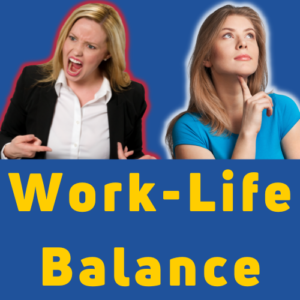In today’s episode, I look at how Sweden and the US handle the concept of work-life balance. I will focus on five aspects; work culture, flexible work conditions, vacation, sick leave, and parental leave.
Access to paid time off and the ability to rebalance work and life are crucial to creating a successful work-life balance.
Work Culture

At first glance, the work cultures of Sweden and the United States may seem very different, but upon closer inspection, there are many similarities. In Sweden, the Swedish work culture places a high value on teamwork with an emphasis on collaboration and innovation. In addition, special emphasis is placed on Work-life balance and employee loyalty; employees are encouraged to take breaks throughout the day and receive time off during vacations or family events. In Sweden, there is a strong emphasis on work-life balance and maintaining an equal distribution of power between employers and employees. Sweden Workers are more likely to work shorter and more flexible hours than their U.S. counterparts. Additionally, Swedish labor law provides greater protection for workers in terms of parental leave policies and remote work opportunities
In America, success is measured by how much wealth one has and the hours one puts into work. Work is seen as a necessity and a source of financial stability rather than a way to improve the quality of life. Workplace loyalty is also highly valued in the US, with employers expecting employees to stay with the company for a long time. On the other hand, the US places less emphasis on work-life balance and has a more competitive culture. American workers are more likely to work longer hours and have less flexible hours. U.S. labor laws also offer fewer workers Protections about parental leave policies and remote work opportunities.
But there are also similarities. For example, both countries strongly emphasize workplace equality, and both highly value work-life balance. Additionally, flexible working hours and remote work opportunities are on the rise in both countries, allowing more employees to participate. Make the most of family time while meeting your employer obligations. The use of technology has also allowed both countries to adopt flexible working hours, giving workers greater freedom and autonomy.
Flexible Working Conditions

Flexible working conditions have become increasingly popular in recent years, allowing employees to work outside traditional 9-5 office hours. In Sweden, these arrangements are often individual and flexible, while the US provides a range of formal options such as flextime, job sharing, telecommuting, part-time work, and compressed workweeks.
Sweden has implemented individual and flexible working conditions, including 480 days of paid parental leave, flextime, job sharing, telecommuting, part-time work, and compressed workweeks. The US offers similar flexible working arrangements but may have more restrictions. For many US workers, the need for flexibility and control over work time means accepting part-time or contingent arrangements. However, hybrid working arrangements are often defined and enforced by the employer. This stands in contrast to the Swedish flexible work model, which gives power to individual employees to make their own decisions about their working hours. The impact of working time on flexibility has been thoroughly studied in Sweden and the US. Sweden’s focus has been on individual and flexible working conditions, such as self-scheduling and flexitime. In contrast, unions have negotiated contracts in the US that increase employee control over working time. Studies have found flexi-time to have a significant negative relationship with employee turnover and a significant positive relationship with organizational profitability.
Vacation

In Sweden, employees are entitled to a minimum of 25 working days of vacation per year (5 weeks), and they have the right to use four of these weeks continuously during the months of June to August, with benefits with an extra 12% on their salary, paid out when they go on leave. They can also save the fifth week for up to five years. If you start a new job after 31 August in any given year, you are only entitled to 5 full days of vacation until 1 April the following year; the so-called vacation year runs from April 1st to March 31st.
The US does not have a statutory minimum for the number of paid vacation days employees are entitled to. While US workers are typically offered ten days of paid vacation and six paid holidays, this falls well below the minimum in most countries.
Sick Leave

Paid sick leave helps to protect employees’ health and financial security, and it is a major factor in reducing sickness absence. In Sweden, employers are required to provide generous sick leave entitlements, allowing employees to take up to 90 days off work a year for illness or injury. In the US, however, there is no national standard for paid sick leave, with only a few states and municipalities providing this benefit. The benefits of paid sick leave are undeniable. Not only does it protect workers’ incomes, but it can also help ensure they receive the necessary medical care while off work. In Sweden, employees who are off sick are entitled to 80% of their salary for up to a year. The Swedish sickness insurance system provides both publicly-funded and employer-funded sick leave compensation. Sick leave benefits include full pay during the first 90 days and partial pay thereafter. Furthermore, dismissal policies are in place to protect employees who require long-term sick leave due to an illness or injury. You can receive compensation for caring for a sick child from the day the child is eight months old until the day before the child turns 12. There are times when you are entitled to compensation even if the child is older or younger, for example, if the child is covered by the Act concerning Support and Service for Persons with Certain Functional Impairments (LSS). This includes taking the child to the doctor, children’s health center, dentist, or child and adolescent psychiatric services and if you are home with the child because the ordinary caregiver is sick. You can receive compensation for caring for a sick child for a maximum of 120 days per year. For the final 60 days, you can only receive the compensation if the child is ill and not if the child’s regular caregiver is ill. The US’s Limited Sick Leave Policies differ from Sweden’s regarding the amount of paid leave provided and the qualifications for taking leave. The US Family and Medical Leave Act of 1993 grants eligible workers an entitlement to unpaid leave for certain family caregiving and medical needs. However, 68 percent of workers with paid sick leave have access to only a fixed number of days per year, with an average of 8 days available. The first seven days of a sick-leave spell in Sweden can be self-certified, while any additional days require a medical certificate. In the US, however, most states offer limited access to paid sick leave, and medical certification is usually required for all absences. In Sweden, employers must first attempt to accommodate the employee’s sickness and offer them a new position or an adapted job. If this is not possible, the employer must provide notice of dismissal with reasonable notice and allow them to submit objections. In the US, employers are not legally obligated to provide any notice or opportunity to object to long-term sick leave cases.
Parental Leave

Sweden has among the most generous parental leave policies, guaranteeing 480 days of paid leave. Each parent is entitled to take at least 90 days of the 480-day allowance, and the remaining days can be divided between the two parents as they wish. Parental leave in Sweden is paid at 80% of regular wages. In 1974, it was the first country to replace gender-specific maternity leave with parental leave, offering both parents 12 months of maternity leave and six months of paternity leave. In 2015, Sweden took further steps to close the gender gap by introducing a third paid month of parental leave for fathers. The Swedish Institute reports that this policy is part of “efforts to achieve gender equality” and that take-up by men is increasing slowly.
In the US, parental leave is not guaranteed by law, and the policies are largely up to employers. While some companies provide paid parental leave, many parents in the US do not have access to it. The Family Medical Leave Act (FMLA) provides up to 12 weeks of unpaid leave for birth or adoption but does not guarantee payment. This means that parents in the US are often put in a difficult situation where they need to take time off of work but cannot afford to do so without financial help. The US remains one of only six countries without mandated paid parental leave.
Reflection from experience (a fictionary story)

I lived in Sweden for ten years before moving to the United States. During those ten years, I worked hard and established a successful career. But I was also able to enjoy life outside of work too.
In Sweden, I felt like there was a great balance between work and leisure activities. Despite working long hours, I still had plenty of time for myself and my family. Even though work was important, it didn’t take over my life.
When I moved to the United States, however, I noticed a drastic change in my work-life balance. Here, it seemed that almost all of my days were filled with work, leaving me little time for anything else. Even when I wasn’t at the office, I found myself thinking about work and trying to finish up any tasks that needed to be done.
It took me a few years to adjust to this way of life and find a balance again. I’m now more mindful of making time for myself and my family despite having busy days at work. Although it can be difficult, I try my best to ensure that work doesn’t overtake my life completely so that I can still enjoy the things that matter outside work.
My Final Thoughts
My experience is that Sweden has a very healthy way of looking at work-life balance, which society supports through laws and financial support. Regarding work culture, the differences between the two countries can be explained by the two social norm systems I talked about in my last episode; the law of Jante and the American dream. Flexible working conditions have changed a lot here in the US since dealing with the pandemic, but even before I moved here in 2003, this was very much a reality in Sweden. The difference when it comes to vacation is probably the biggest difference on a personal level that I have experienced. I also think this is one of the most significant factors for creating a very impressive balance between work and life that many Swedes accomplish. Finally, let me talk about sick leave and parental leave. This accomplishes more than anything else to take away a lot of stress from parents, which is an important part of a healthy work-life balance. There is seldom a question about taking care of your kid financially or being a caregiver in Sweden.
The US could learn much from Sweden to create a balanced relationship between work and leisure time.
Next week I will continue comparing Sweden and the US, and this time I will take a closer look at higher education.




